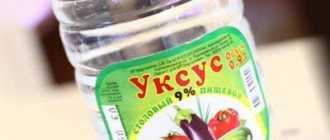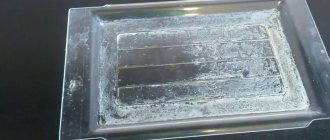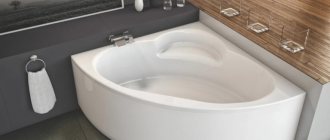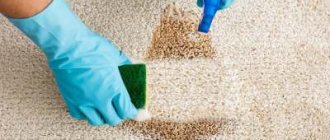A once clean sink, a sparkling white bathtub, even shiny taps and mixers eventually become covered with mineral deposits, unpleasant streaks and stains that cannot be washed off with ordinary cleaning solutions. To prevent the situation from getting worse, you need to urgently take decisive action and use stronger cleaning agents.
Even with regular cleaning of sinks, bathtubs, toilets and other plumbing fixtures, limescale deposits gradually appear on them. Water contains dissolved minerals, which do not disappear when it dries, remaining on the surface and forming deposits. These deposits are usually very resistant to conventional cleaning agents and require extensive measures to remove limescale deposits. We'll tell you how to remove limescale depending on the surface on which it formed.
Do not forget that all work with strong caustic solutions should be carried out wearing protective gloves !
Enameled sanitary surfaces
To avoid damaging the enamel, do not use metal brushes for cleaning. The best option would be a soft foam sponge or cloth.
Of course, the surest way is not to run and regularly clean the enamel bathtub and other enamel-coated plumbing fixtures. But over time, even with regular care, rust stains, waterstone deposits and other unpleasant consequences of long-term use may appear, spoiling the appearance. How to completely clean enameled plumbing fixtures and return them to their original appearance?
Acid method
Lime deposits are easily dissolved by acids. The most popular household acids are acetic and citric. We will use them.
- Lemon acid. Take at the rate of 50 g per 2 glasses of warm water. Dissolve so that no grains remain. Dampen a soft sponge in the resulting solution and wipe it over the entire surface to be cleaned. Without rinsing, repeat the procedure after 15 minutes, carefully walking through the contaminated areas. Dense lime deposits can be removed by placing a cloth or napkins soaked in the same acidic solution on top of them and leaving for 20–30 minutes. Then rinse with water. If the deposits have not completely disappeared, the procedure can be carried out again.
- Vinegar. Instead of citric acid solution, you can use 9% vinegar (not essence!). The algorithm of actions is the same as in the previous case, just be careful - do not inhale the caustic fumes. After vinegar treatment, the room should be ventilated.
Alkaline method
- Mix baking soda and soda ash in equal proportions, add a little water to form a paste. Rinse the item to be cleaned with water to keep it damp. Apply the resulting slurry, rubbing it evenly over the entire surface using a soft sponge. Leave for 20 minutes, then wipe with a sponge soaked in clean water. Rinse off.
Combined method
To achieve maximum cleansing effect, you can combine both methods. So, almost any limescale deposits, rust streaks and other contaminants from an enamel bathtub, sink and other enamel-coated products can be removed as follows:
- First we proceed as in the alkaline method. Mix baking soda and soda ash in equal proportions, add water until a thick mushy mass is formed, which is then evenly spread over the enamel surface of the product. Leave for 20 minutes.
- Without removing the slurry that was applied a step earlier, lightly rub everything with a soft sponge or rag soaked in 9% vinegar. Leave for 20 minutes.
- We wet the sponge in clean water, wipe everything with it again, rinse thoroughly and enjoy the cleanliness.
Don’t forget to work only with gloves, otherwise you can remove the skin from your hands along with the dirt.
Reasons for the formation of lime deposits
White growths are insoluble calcium carbonate. It forms in areas with stagnant water, remains on the surface after moisture evaporates, accumulates over time and turns into white crystals or scaly formations.
The main reasons for the appearance of lime deposits:
- Untimely flushing of water . Often white growths appear on individual elements of plumbing and household appliances. On toilets and urinals, lime deposits form together with urinary stones. Cleaning such surfaces is problematic; sometimes even professional products do not help. Therefore, it is better to avoid the appearance of limescale build-up, carry out regular cleaning, cleaning surfaces, and, if necessary, adjust the flushing system.
- Hard or hot water . Plaque quickly forms in coffee makers, washing machines, dishwashers or electric kettles. To prevent this, the heating elements must be cleaned regularly and additional water softeners must be used.
- Damaged surface . Limescale occurs when water collects in chips or cracks. Products that penetrate deeply into contaminants help to clean such places.
Acrylic bathtubs, sinks and other acrylic products
If you are the proud owner of an acrylic bathtub or other acrylic bathroom fixtures, be careful when trying to clean your plumbing marvel. Acrylic is very sensitive to aggressive chemicals and abrasives. Therefore, we immediately sweep aside any cleaning powders and brushes with hard or metal bristles.
It is better to clean acrylic plumbing fixtures from limescale only with the help of special detergents designed specifically for cleaning acrylic surfaces . It is not advisable to use concentrated alkalis or acids; the surface can be damaged, and abrasive powders will leave scratches.
citric acid to remove limescale . For this:
- Fill the bathtub (or sink) with hot water.
- Dissolve 100 g of citric acid in a small container, for example in a glass jar (so that the powder is completely dissolved and then does not settle to the bottom), pour it into the bath, stir.
- Leave for 2-3 hours.
- We drain the water, wipe with a sponge, rinse with running water and wipe dry.
The best foams for cleaning baths
Foam products are especially convenient for cleaning hard-to-reach areas. They also easily penetrate the pores of the surface and are suitable for removing old dirt.
Sano Jet - universal cleaning foam for the bathroom
5.0
★★★★★
editorial assessment
98%
buyers recommend this product
Sano Jet is a foam for washing almost all surfaces in bathrooms. It is suitable for taps made of chrome and stainless steel, plastic, ceramics, tiles, bathtubs with acrylic or enamel coating.
The composition does not contain abrasives, so it does not leave scratches on difficult-to-clean surfaces.
The formula includes a surfactant complex and citric acid that cope with rust and mineral deposits. Users note that after cleaning, a shine appears on the plumbing fixtures, and the surface becomes much lighter.
When applied, the liquid from the bottle turns into a lush foam, which, when drained, softens and dissolves plaque. The composition should be left for 3-5 minutes, and for severe contamination - for 10.
For maximum results, housewives are advised to manually distribute the foam evenly with a sponge along the walls of the bathtub, since it itself drains in a chaotic manner.
There is no need to scrub the plumbing fixtures with a brush; just rinse off the product with water. The foam is sold in a convenient liter bottle, which is enough for several months of use.
Pros:
- Suitable for cleaning all surfaces in the bathroom;
- whitening effect;
- does not require mechanical cleaning;
- fast action;
- washes away most contaminants;
- economical consumption.
Minuses:
- not sold everywhere;
- acrid smell.
When purchasing, users recommend buying several bottles of the product at once, since it is difficult to find on sale and is quickly sold out.
Sanfor Acrylight – disinfectant foam
5.0
★★★★★
editorial assessment
95%
buyers recommend this product
Sanfor Acrylight is a cleaning foam for disinfecting and removing dirt from bathtubs, Jacuzzi systems, and showers.
The formula is based on lactic and citric acids, which clean surfaces from grease, soap and lime deposits. This composition is suitable for acrylic, glass, plastic, enamel or chrome coatings, and after rinsing it does not leave streaks or scratches.
The thick consistency ensures uniform distribution of the composition along the walls of the plumbing fixtures, and a convenient dispenser makes the product consumption small.
The bottle is carefully thought out by the manufacturer: the slanted neck allows you to pour foam into hard-to-reach places, the lid is childproof, and the anti-slip surface of the bottle prevents it from slipping out of wet fingers.
Pros:
- disinfects and has an antimicrobial effect;
- has economical consumption;
- suitable for most coatings;
- convenient bottle.
Minuses:
- does not remove rust;
- leaky lid.
Users note that sometimes Sanfor Acrylight bottles have a leaky lid and the liquid can spill. Therefore, they recommend transporting and storing the product only in an upright position.
Nordland “Lemon” – biodegradable composition
5.0
★★★★★
editorial assessment
91%
buyers recommend this product
Nordland is an Italian product for the care of acrylic bathtubs, tiles, showers, mirrors, taps, glass and plastic parts.
Foam penetrates into hard-to-reach places, disinfects and removes even stubborn stains, rust, grease and oil traces, as well as lime and soap deposits.
The formula decomposes by 90% after use and does not harm human health or the environment. It washes off easily and does not require additional effort.
The aroma of lemon is pleasant and allows you to use the product even in unventilated areas. After cleaning, the plumbing remains clean longer thanks to the protective film.
Pros:
- antibacterial effect;
- removes all types of contaminants;
- biodegradable formula;
- pleasant aroma;
- does not require mechanical cleaning;
- penetrates into hard-to-reach places;
- prevents further contamination of plumbing fixtures.
Minuses:
- high consumption;
- difficult to find on sale.
Nordland is a cleaning product for those who care about their own health and the preservation of the environment. The biodegradable composition combined with high efficiency makes this foam a clear top seller.
Stainless steel
Removing limescale from a stainless sink, bathtub or other plumbing fixtures should be done with caution, as strong reagents can leave black streaks. Therefore, we either use special means for cleaning stainless steel, or inexpensive improvised means, but with caution so as not to cause harm.
Here is a simple, cheap, safe, but effective way to clean water scale from stainless steel plumbing fixtures:
- Mix 9% table vinegar and hydrogen peroxide in a 2:1 ratio. For washing, 6 tablespoons of vinegar and 3 tablespoons of hydrogen peroxide are usually enough. A stainless steel bath will require a few more ingredients. We thoroughly spray the surface with the resulting solution from a spray bottle, do not forget about the chrome-plated parts of the mixer, and place napkins or pieces of clean cloth soaked in the same solution on areas with particularly strong limescale deposits. Leave for 20–30 minutes.
- We wipe with a sponge; we go through inaccessible or particularly dirty areas with a toothbrush. Wash off with clean water. If necessary, repeat the procedure.
- Wipe dry. To bring the final shine, wipe everything with a slice of lemon or spray it with glass cleaner, wipe it again with a dry cloth and enjoy a clean, fragrant and shiny surface.
What not to use
Manufacturers of household chemicals offer customers products with a balanced composition. They are responsible for quality and honestly warn about risks. But there are housewives who prefer to use improvised means to clean the bathtub. At best, they do not give the desired result. At worst, the bathtub coating suffers, microcracks appear, and service life is reduced.
For cleaning it is not recommended to use:
- washing powders;
- cleaning pastes containing abrasive particles;
- chlorine;
- gasoline and acetone;
- alcohol emulsions.
Chlorine-containing products are strictly prohibited for cleaning acrylic bathtubs. Enamel is afraid of bleaches and abrasives. They cause scratches and defects to appear on the surface.
Ceramics: faience and porcelain sanitary ware, ceramic tiles
Waterstone can also form on ceramics. In earthenware or porcelain toilets, near faucets on sinks, around drain holes, on ceramic tiles along the bathtub, and so on - wherever tap water gets in.
How to remove limescale from a ceramic surface? Citric acid is perfect for this .
- Prepare a saturated solution: pour 100 g of citric acid in powder form into 200 ml of warm water, stir thoroughly so that no crystals remain.
- Pour the prepared solution into a spray bottle.
- generously onto the ceramic surface. For greater effectiveness, rub with a sponge as you spray. We don’t save the solution. Then wait 15–20 minutes.
- Wipe again with a wet sponge, then rinse everything off with water and wipe dry.
- If there is plaque left somewhere, place napkins or pieces of cloth soaked in the prepared solution on such difficult areas. Do not touch for half an hour, remove the applied cloth or napkins, clean off the softened plaque with a toothbrush, then rinse everything off with water and wipe dry.
The method is quite effective, safe, cheap and accessible to everyone. Instead of a citric acid solution, the surface can be wetted with 9% food vinegar, apply pieces of cloth soaked in the same vinegar to particularly dirty areas on the ceramic, wait half an hour and wipe with a sponge. Then wash it off. However, vinegar will produce strong fumes; citric acid does not have this problem, and the effect is no worse.
Tips for daily care
- After each use of the bathtub, rinse it with warm water from the shower.
- Once a week, use household chemicals for cleaning, choosing an option based on the type of plumbing.
- Give preference to liquid and gel cleaners that will not scratch delicate surfaces. Use powders occasionally, if necessary.
- At the end of the day, try to leave the surface of the bath dry. Constant moisture can cause rust, plaque, and ingrained yellowness. Use a soft cloth to wipe.
Chrome or nickel plated parts of taps, mixers, aerators, sprayers
No coarse or abrasive products, no metal brushes - all this can irreversibly damage the decorative coating and it will not be possible to restore it later.
To remove limescale from the holes in the shower head , it should be disassembled. Soak parts with nozzles in heated 9% vinegar for 30–60 minutes. Then rinse with water and, if necessary, brush with a toothbrush. Assemble the watering can and attach it back to the hose. If you can’t disassemble it, then soak the entire tip of the watering can.
The same thing applies to the aerator (the nozzle on the faucet spout). It should be removed - it unscrews easily.
Then rinse in running water, soak in heated 9% vinegar for 30–60 minutes, rinse again in water, if necessary, clean off the softened plaque with a toothbrush and screw it back on.
When soaking plumbing parts in vinegar, do not forget to cover the container with cellophane to minimize evaporation.
We clean the chrome or nickel plated parts of the faucet from water stone.
- Lemon. If the contamination is not too serious, you can get by with regular lemon: rub the parts of the mixer with a slice of lemon. Leave for 20-30 minutes, then rinse with a sponge soaked in water and wipe dry.
- Vinegar. More serious lime deposits can be removed with vinegar. Moisten the parts with 9% table vinegar. Wrap the most contaminated areas with pieces of cloth or napkins soaked in vinegar. Wait about half an hour, rinse, clean hard-to-reach areas with a toothbrush, and wipe dry.
For final cleaning of nickel and chrome plated surfaces, removing dark spots or stains, toothpaste is excellent. Apply a small amount to the cotton wool and rub thoroughly until shiny. Remove any remaining paste with cotton wool or a dry cloth and enjoy the cleanliness!
Glass
Experience shows that cleaning glass surfaces is not difficult. Ordinary laundry soap will help deal with simple stains, and if anything remains, it can be easily removed with a solution of citric or acetic acid. Glass is very resistant to acids, and therefore you can use them in significant concentrations , mercilessly dissolving any deposits. The final shine and cleanliness of glass surfaces will be given by a glass cleaner with a spray bottle.
Plastic
Lime deposits can form on plastic, like on any other surface. This is especially true for plastic pallets. How to effectively clean plastic?
To avoid scratching a soft plastic product, you should not rub it with hard (especially metal) brushes and abrasives. A delicate approach is required. And ordinary vinegar will help us again.
We take 9% table vinegar. Apply to plastic using a soft sponge or spray bottle. As usual, we apply pieces of cloth or napkins soaked in vinegar to particularly contaminated areas. You can pour vinegar into a plastic tray; the tray is usually not very deep, and vinegar is inexpensive - so we pour it to the brim and cover it with cellophane (so it doesn’t stink so much). Leave for about 20 minutes. And a soft sponge or napkin, carefully wipe off the softened plaque (if it has not completely dissolved by this time). Rinse with clean water and wipe dry. Instead of table vinegar, you can use a solution of citric acid - 25 g of acid per 1 glass of water.
If you know how to clean any surface from limescale and are not lazy, your plumbing will always delight you and your family with its cleanliness and beautiful appearance.
Taking into account the coating material
Different materials require an individual approach to combating limescale. Before the process you must:
- read the manufacturer's recommendations,
- carefully study the labeling and instructions on the packaging of the industrial product,
- take into account the properties of the surface when preparing a home remedy.
Acrylic
Bathtubs made of polymer materials attract buyers with their light weight, low price and variety of shapes. They are easy to clean due to the absence of pores on the surface and are less susceptible to contamination.
For regular cleaning, a soap solution and a sponge are sufficient . If the moment is missed, the bowl of the product is covered with lime deposits, it is necessary to use industrial sprays and gels with special markings (Cif Cream, Acrylan, Sun Klin) or a home solution based on citric acid or lemon juice.
To care for a bathtub made of polymer materials, only special sponges are used, for example, “Chistulya” for acrylic, enamel and earthenware.
Enameled
The enamel coating, according to GOST, has a number of features:
- resistant to alkali (sodium hypochloride, chlorine-containing bleaches, soda);
- tolerates cleaning with industrial abrasive detergents (Comet, Pemolux);
- does not allow prolonged contact with inorganic acids (contained in “Toilet Duckling” products, some types of Cillit Bang).
Prolonged contact with strong acids destroys the enamel, the surface loses its shine, color, and becomes rough.
Steel
Bathtubs are more resistant to mechanical damage, which can lead to rust, than cast iron.
They do not tolerate high temperatures well. It is unacceptable to wash a steel bowl with hot water ; this will lead to cracking of the enamel.
The choice of means for removing plaque from such a product is quite wide: from cleaning and bleaching agents to concentrated gels and solutions. Mandatory condition: in tandem with a soft foam sponge.
Cast iron
Bathtubs made of cast iron are durable, stable, not subject to corrosive processes and retain heat well.
To keep the enamel surface clean, regular detergent and a soft sponge are sufficient after each use . If plaque does form, you can use both powdered products and liquids containing chlorine, alkali and weak acids for removal.
It is necessary to avoid mechanical damage to the surface, this will accelerate the formation of stains and plaque in the future.











